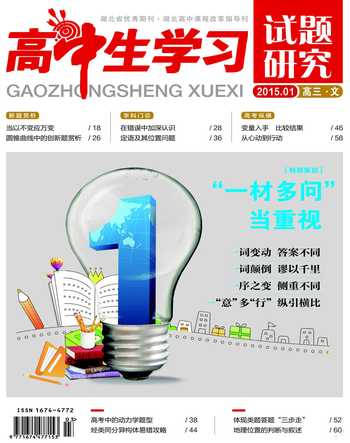任务型阅读一例
2015-05-30廖英
廖英

请阅读下面短文,并根据所读内容在文章后表格中的空格里填入一个最恰当的单词。
The expression, “everybodys doing it”, is very much at the center of the concept of peer pressure. It is a strong influence of a group, especially of children, on members of that group to behave as everybody else does. It can be positive or negative. Most people experience it in more than one way during their lives.
People are social creatures by nature, and so it is hardly surprising that part of their self—respect comes from the approval of others. The distinct is why the approval of peers, or the fear of disapproval, is such a powerful force in many peoples lives. It is the same instinct that drives people to dress one way at home and another way at work, or to answer “fine” when a stranger asks “how are you?” even if it is not necessarily true. There is a practical aspect to this: it helps society to function efficiently, and encourages a general level of self-discipline that simplifies day-to-day interaction.
For certain individuals, seeking social acceptance is so important that it becomes like an addiction; in order to satisfy the desire, they may go so far as to abandon their sense of right and wrong. Teens and young adults may feel forced to use drugs, or join gangs that encourage criminal behavior. Mature adults may sometimes feel pressured to cover up illegal activity at the company where they work, or end up in debt because they are unable to hold back the desire to buy a house or car that they cant afford in an effort to “keep up with the Joneses”.
However, peer pressure is not always negative. A student whose friends are good at academics may be urged to study harder and get good grades. Players on a sports team may feel driven to play harder in order to help the team win. This type of influence can also get a friend off drugs, or to help an adult take up a good habit or drop a bad one. Study groups and class projects are examples of positive peer groups that encourage people to better themselves.
Schools try to teach kids about the dangers of negative peer pressure. They teach kids to stand up and be themselves, and encourage them to politely decline to do things that they believe are wrong. Similarly, it can be helpful to encourage children to greet the beneficial influence of positive peer groups.
随着新课改的实施,2006年起浙江、江苏、上海等城市陆续采取一种新的高考阅读理解考查形式,即任务型阅读。它要求考生根据文中提供的信息用恰当的词语完成与短文相关的图表,增加了读写的要求。相对于传统阅读理解,更突出“表达”强调在语言输出的基础上加强语言输出能力的考察。但萬变不离其宗,任务型阅读仍属于阅读范畴,题目设置和传统阅读一样,都是旨在围绕不同的阅读技能和语言运用而展开,涉及词性转化、词语释义、同意替换、结构分析、细节理解、语法结构、归纳演绎等。我们以上文中的2014年江苏高考的任务型阅读为例,在传统阅读理解的解题思路基础上,来学习分四步如何解答这类阅读题。
1. 先阅读,再做题。任务型阅读文章长,词汇多,句式复杂,考生还是需要先通读一遍文章才能对文章的话题和结构有大体了解。
2. 分析结构,找主题句。任务型阅读非常强调考生的语篇分析能力,学生的读后需要自己归纳总结并提炼语言将其核心词写出来。文章结构多为三部分:开头(引入话题)、主题(探讨话题)、结尾(总结观点),主题句多安排在语段的开头与结尾。
这篇任务型阅读图表设置了三个小标题,它们简明扼要地概括出了文章的主要内容。我们可借助三个小标题与其下属的细节信息将文章分成三部分。通過分析,我们得知第二段的主题句在段末,即There is a practical aspect to this: it helps society to function efficiently, and encourages a general level of self-discipline that simplifies day-to-day interaction,第3题属于归纳词的原词再现,答案为practical,主题句可简化为 A practical function of peer pressure to society。至于75题,3、4、5自然段的主题句都在句首,分别是:For certain individuals, seeking social acceptance is so important that it becomes like an addiction;However, peer pressure is not always negative;Schools try to teach kids about the dangers of negative peer pressure.我们将其归纳概括,即为Influence of peer pressure on individuals。
3. 按图索骥,锁定出处。这里的“图”是指问题中的信号词,根据它,我们可以在文章中定位出答案依据的大致位置。在根据三个小标题对文章进行分段后,我们可知道作答71、72应锁定第一段,74题为第二段。同时根据题干中信号词Negative influences/Positive influences/Kids should learn得知76需定位在第三段,77、78为第四段,79、80则为第五段。
4. 先变形,再答题。传统阅读理解在设置正确选项时,极少使用文本中原句,命题人往往是将文本信息用不同语言形式再现出来。任务型阅读中的题目也强调对文章主要内容的转述或概述,但这类考察难度更大,学生需写出来而不再是选出来。所以考生在填写答案之前,一定要先想一想是否需要转变表达的形式。题型主要包括原词重现(73、78)、同义替换(76、79、80)、词性转换(72)、提炼概括(71、74、75、77)四大类,四种题型难度指数依次上升。
71题为总结概括题。原文是It is a strong influence of... everybody else does,但题干为Peer pressure refers to the strong that you must do things the way other people of your age do。题干中所需要的是个抽象名词,且后面跟的同位语从句的语意决定了答案是feeling而非influence。72题为词性转换题,influence的词性从文中的名词变成了动词。74题也是总结概括题。原文:It is the same instinct... it is not necessarily true. (L3, P2) 同样是这种本能驱使着人们在家和工作时穿不同的衣服,当别人问道“你好吗?”时回答“我很好!”——尽管事实并不一定如此。此乃天性使然,非故意而为之——所以周围的人们是无意识地(unconsciously)影响着我们生活。76题涉及到同义替换,原文:In order to satisfy... right and wrong. (L2, P3) 有些人为了满足自己的需求,可能会泯灭自己的是非观念,也就是道德观念(lack of moral sense)。77、78可锁定原文: Players on a sports team... a good habit or drop a bad one. (L2/3, P4) 通过总结概括与原词再现可知Positive influences are good grades, team spirit and building-up of good habits. 79、80则涉及到同义替换。原文:Schools try to teach kids... they believe are wrong (L1, P5)中的stand up and be themselves即“be independent”。politely decline to do things that they believe are wrong即say no to anything wrong。
对于湖北考生而言,通过写来输出所输入的文本信息的训练不多。攻破这类任务型阅读,大家需一方面不断提高自己的词汇量,另一方面可以先从一些涉及词性词性转换的常规题入手,如“用所给词适当形式填空”。借助于这些基础题,不断提高自己对词性与固定搭配的敏感度,培养语言表达的灵活性与多样性。
